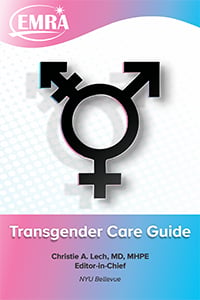Terminology
One of the most important aspects of the doctor-patient interaction is establishing a rapport and making patients feel safe. Research has shown that poor patient–provider communication is strongly associated with adverse health outcomes.5 When caring for trans patients, understanding and utilizing correct terminology is the initial step in establishing effective communication, making patients feel comfortable and welcome in the ED. But gender terminology and identity is quite complex; for example, Facebook has more than 50 different gender options, and the list is constantly expanding.
- Sex refers to the biological and physiological characteristics that define men and women.
- Gender refers to socially constructed roles, behaviors, activities, and attributes society considers appropriate for men vs. women.
What is transgender?
When a person’s internal sense of gender identity or expression does not align with their sex assigned at birth
What is transsexual?
When a person alters their body via hormones and/or surgeries to align with their sense of gender identity. This term has largely fallen out of favor.
What is cisgender?
A person whose current gender aligns with their birth sex
What is gender nonconforming?
A person whose appearance and behavior do not conform to societal expectations or cultural norms of what is appropriate for each gender
What is gender fluid?
A person who does not identify with a fixed gender identity, and their sense of gender may fall somewhere on the spectrum between male and female, as well as change over time
What is gender non-binary?
A person who does not choose to identify as male or female or feels their gender is outside the binary of male or female
What is trans?
This is a term often used to describe the entire trans, non-binary, and gender non-conforming community
What is AFAB or AMAB?
This term stands for Assigned Female At Birth/Assigned Male At Birth and can be used to describe people who fall in a variety of current gender categories but have a particular birth gender
What is TGNB?
This stands for Transgender/Non-Binary and is a term used to include various people whose gender does not match that assigned to them at birth
LGBTQ
This acronym is often changing, and various letters are included in different permutations. In this resource we are referring to Lesbian, Gay, Bisexual, Trans, and Queer people. However, in other settings you might see Questioning, Intersex, Asexual, Allies, or Two Spirit people included specifically.
Examples
- Transgender male/man: a person who is born female sex, but their sense of gender is male
- Transgender female/woman: a person who is born male sex, but their sense of gender is female
This is by no means an exhaustive list, and the language surrounding gender identities is rapidly changing every day, and from place to place. A person’s sense of gender is not always binary as in “male” and “female” and may fall somewhere on the spectrum between the two or may change over time.
Pronouns
While general terminology helps familiarize the provider with the trans/non-binary community, the most important terms to establish with a patient are the pronouns the individual prefers.
While some may prefer the gender-based “he/him/himself” or “she/her/herself,” there are many other variations. Others may prefer more gender-neutral pronouns, such as “they/them/themselves” or “ze/hir/hirs/hirself” or “ze/zir/zirs/zirself.” While these are some of the more common pronouns, there are many other examples. It is best to simply ask the patient what pronouns they prefer.
In a situation where your patient’s gender may not be apparent, it is best to simply ask them what pronouns they prefer.





